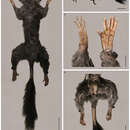fi
nimet breadcrumb-navigoinnissa


Members or this family have very well developed bi-focal vision, an excellent sense of smell, and acute, possibly ultrasonic, hearing. They are believed to depend on scents, as well as sounds for communication. Twittering calls have been noted.
Communication Channels: visual ; tactile ; acoustic ; chemical
Perception Channels: visual ; tactile ; acoustic ; ultrasound ; chemical
Z. insignis is extremely rare with an unknown status. It is listed, by the International Union for Conservation of Nature and Natural Resources, as lower risk in the near threatened category.
US Federal List: no special status
CITES: no special status
IUCN Red List of Threatened Species: least concern
These animals are not reported to have any negative impact on humans.
These animals have no documented economic importance to humans.
The role of Z. insignis in the ecosystem has not been commented on in the literature. However, it is likely that they have a role similar to that of other members of their family. Members of this family are believed to greatly impact their ecosystem via a mutually beneficial relationship they have co-evolved with their food trees. Anomalures can use their incisors not only to eat, but also to cut small branches off trees. They use this ability to cut the tops off of young trees, a behavior called pruning, which kills young competitors near the base of their food trees. This pruning may provided their food trees with a competitive advantage. It has been observed that these specific trees are often dominant or are common in the areas where members of this family, Anomaluridae, are known to live.
The diet of Z. insignis has not been reported. However, they are probably like other members of their family with respect to diet. Members of the family Anomaluridae have been successful due to the specificity of their diet. Their primary food source is the bark which they gnaw from a small group (about a dozen specific species) of trees. The location of these trees is indicative of the locations of anomalures. Anomalurids have also been known to eat fruits, leaves, and flowers. They also probably eat small invertebrates: insects, larvae, and grubs.
Animal Foods: insects
Plant Foods: leaves; wood, bark, or stems; fruit; flowers
Primary Diet: herbivore (Lignivore)
Cameroon, or flightless, scaly-tailed squirrels (Zenkerella insignis) inhabit the high forests of Western central Africa, from the Cameroons to the Congo.
Biogeographic Regions: ethiopian (Native )
The principle habitat of Cameroon Scaly-tails is tropical forests. The species has only been found from Cameroon to Gabon, and is thought to occupy the canopy.
Range elevation: 40 (high) m.
Habitat Regions: tropical ; terrestrial
Terrestrial Biomes: forest
Little is known about the lifespan of this species.
Z. insignis is small, weighing 180 to 220 g. The head and body length is between 18 and 23 cm. This species has a dense, soft, slate grey fur, with ochre tints on the forearms, lower shins, and cheeks. It has a lighter underside, and a darker, bushy tail that measures 15 to 17 cm in length. The ankles also have a tuft of darker ‘spoon-hairs’, which cover a glandular area. The function of this glandular area is still not known.
Z. insignis resembles the other members of its family (Anomaluridae), possessing two rows of pointed scales on the underside of the tail near the base. These scales are thought to prevent slipping when at rest while climbing. Cameroon scaly-tails differ from their closest relatives in that this species is the only member of the family which does not possess a gliding membrane. Members of the species are therefore sometimes referred to as flightless scaly-tailed squirrels. Members of Anomaluridae are noted to have very well-adapted 'bat-like' claws, and very large eyes.
Range mass: 180 to 220 g.
Range length: 18 to 23 cm.
Average length: 22 cm.
Other Physical Features: endothermic ; bilateral symmetry
Little is known about predation on Z. insignis. It is likely that they might be prey to diurnal predators capable of gleaning them from the canopy of the forest.
Little is known about the reproductive behavior of Zenkerella. However members of the family Anomaluridae are believed to live singly or in mated pairs.
Details on the reproductive behaviors of this species are lacking. Members of the family Anomaluridae most likely have one or two offspring at a time, but have been noted to have up to three precocious young. The timing of sexual maturity, age to independence, age at weaning, gestation period, size at birth, and breeding season are not known.
Breeding interval: The breeding interval of Z. insignis is unknown.
Breeding season: The breeding season of this species has not been reported.
Range number of offspring: 1 to 3.
Average number of offspring: 1-2.
Key Reproductive Features: iteroparous ; gonochoric/gonochoristic/dioecious (sexes separate); sexual ; fertilization ; viviparous
Anomalures are born precocious, with their eyes open and with a thick coat of fur. Their mothers provide milk, and the young grow quickly. They are weaned on pre-chewed food from the cheek pouches of both parents. It is reasonalbe to think that Z. insignis bears similarity to other members of its family in these areas.
Parental Investment: no parental involvement; precocial ; male parental care ; female parental care ; pre-fertilization (Protecting: Female); pre-hatching/birth (Provisioning: Female, Protecting: Female); pre-weaning/fledging (Provisioning: Female); pre-independence (Provisioning: Male, Female)